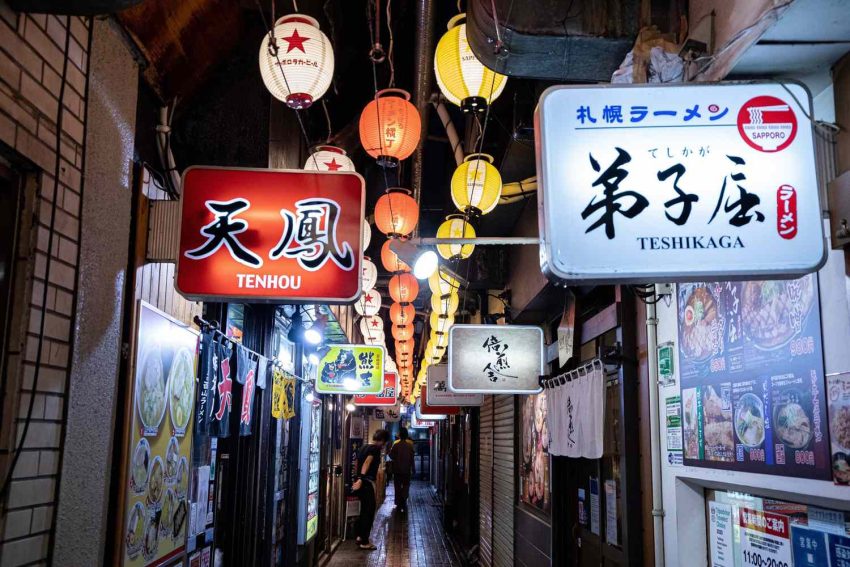I hear the music before I smell the food; the full-flavored riffs of AC/DC. Then, as I duck to enter the tiny restaurant, I get a waft of something even heavier: a perfect, sizzling harmony of umami. A handful of diners are clustered around a wooden counter, their rapt expressions mimicking the song, “Thunderstruck.”
The city of Sapporo, Japan’s northernmost metropolis, is renowned for seafood, skiing, and its international snow festival. But to foodies, it has one claim to fame above all others: Ganso Ramen Yokocho. Otherwise known as “Ramen Alley,” this unassuming artery deep in Sapporo’s neon heart gave the world miso ramen — and continues to serve it to delicious perfection today.
For true believers, Japanese ramen shops are holy places, and this is the ultimate shrine. Located amid the buzzy izakaya taverns and karaoke parlors of Susukino, Sapporo’s nightlife district, this lantern-lit alleyway is home to no less than 17 neighboring ramen restaurants — each lending their own unique twist to the ultimate comfort food.
Mat Willder
My first stop, at the alley’s northern end, is Haruka, which is nicknamed “The Rock-and-Roll Ramen Shop” for its thumping soundtrack and the brightly colored electric guitars dominating its minuscule walls. With space for eight diners, it’s one of the smaller eateries on the alley but serves some of the richest, most textured ramen.
“Finding the perfect ramen is my forever theme,” said Yuya Sasaki, Haruka’s chef, as he hands me a piping-hot bowl of buttery sweet goodness, topped with melting cheese. “It’s crazy that miso ramen started right here and is now eaten all over the world, but I always say that good ramen is like good music — it works everywhere.”
The precise origins of miso ramen are disputed. Some claim it came about when a sleepy cook confused his pots, others when a drunk customer demanded noodles in his miso soup. But everyone concurs that it started here, in the capital of Hokkaido — Japan’s enormous northern island with its snow-blanketed peaks and bubbling hot springs — right after the Second World War. By the time the Winter Olympics came to Sapporo in 1972, the city had consolidated a ragtag gaggle of street vendors into one strip of permanent premises, now known as Ramen Alley.
Courtesy of Visit Sapporo
To the uninitiated it might seem little more than a thick noodle soup, but a well-executed ramen should be a complex, layered dish. Across the alley from Haruka, Tetsuya Tanaka, the headband-wearing chef of Ichikura (meaning “Lucky Storehouse”) told me the secret is in the balance of ingredients.
“Each bowl of ramen is different, like the waves of the ocean,” said Tanaka, who has been cooking on Ramen Alley for 13 years. “We cannot expect the same bowl twice, but we can get close with the right blend of fried vegetables, broth, miso, noodles and topping. The base of the broth is incredibly important. It’s what ties everything together.”
Tanaka, like the heavy metal-loving Sasaki, takes his craft seriously – almost religiously. It’s the same story up and down Ramen Alley, where a solitary chef presides over each establishment like a warrior monk. Customers squeeze and shuffle their way down the tight thoroughfare, peering through windows for empty seats, before slipping inside for a bowl of warming goodness, typically costing around $7.
Jonathan Thompson/Travel + Leisure
Opposite Ichikura, I’m fortunate enough to grab an open spot at Tokuichi Tomiya, which means “Special Fortune” — the most famous restaurant on Ramen Alley. Passed from father to son, it’s been here for five decades, amassing a glittering collection of awards in the process, including multiple national Ramen of the Year titles. With 20 seats, it’s the largest eatery on the alley, and its walls are cluttered with the framed portraits of famous patrons, from professional sumo wrestlers and baseball players to the Glenn Miller Band.
The convivial head chef, Yomichiro Kosaka, serves me a steaming bowl of aromatic ramen, topped with a generous scoop of corn and a chunk of butter, in traditional Hokkaido fashion, before instructing me on how to eat it properly.
“You have to slurp like this,” he said, inhaling ramen with a sound somewhere between coffee machine and vacuum cleaner. “You’re trying to extract the most flavor from the noodle while simultaneously cooling it down — and showing the chef your appreciation.”
Mat Willder
This chef is surprisingly open about the secret ingredient behind his family’s success — mackerel-infused lard — but considers himself, like the others, an artist and creator as much as a cook. “All my life I’ve been striving to make perfect ramen,” he said, chuckling at my pitiful attempts to slurp the crinkly yellow noodles from my bowl. “It’s something of a spiritual quest. Everyone on this alley is trying to reach the same point; to climb the mountain of perfection.”
As the years go by, Kosaka said, more and more foreign visitors find his beloved alley and take a seat at his family’s counter. “I’m surprised how this little lane and its ramen have become so famous,” he said. “We’ve had people from Indonesia, Argentina, Brazil, Italy, and France in here already today. I hope the warmth of the food and the warmth of the welcome speaks for itself.”
In many ways, that “warmth” is close to the distillation of Sapporo’s purest soul: a friendly northern city with a relaxed, easygoing attitude, a world away from the tumultuous flux of Tokyo. The perfect place, in fact, to give birth to the perfect soul food.
